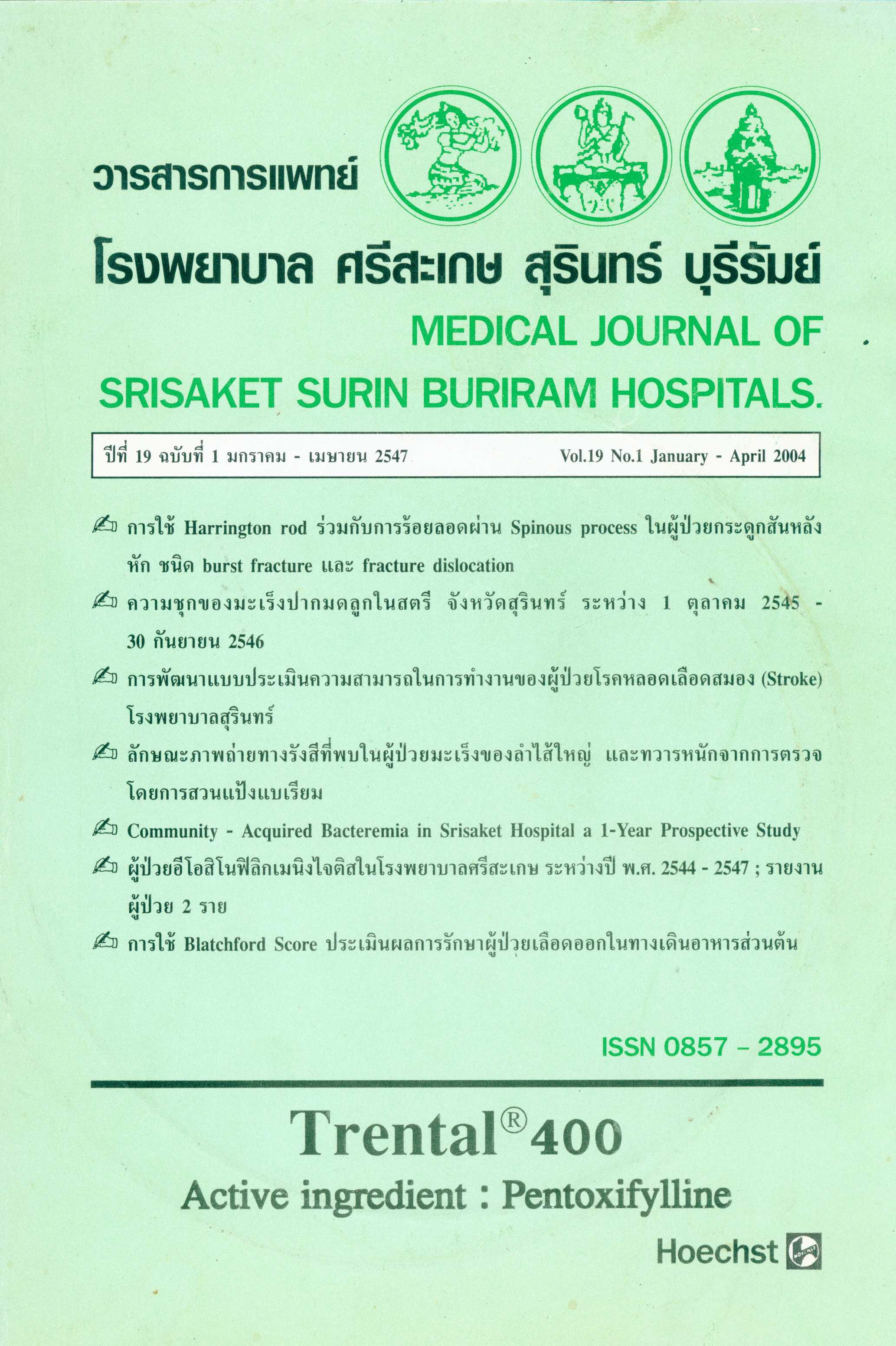Community – Acquired Bacteremia in Srisaket Hospital a 1- Year Prospective Study
Main Article Content
บทคัดย่อ
Over a one – year prospective study of community – acquired bacteremia in Srisaket Hospital revealed 261 patients with bacteremia. The overall incidence and mortality were 6.5/1000 admissions and 39.5 percent, respectively. 152 patients (64.7 percent) with bacteremia were community – acquired infection, of which 89 patients (58.6 percent) were mere males and 63 patients (44.4 percent) were females. The mean age was 51.9 years (range 15-90 years). The statistical difference of mortality in relation to sex or age was not significance. In 148 patients (98 percent) with community – acquired bacteremia a single organism was isolated, most commonly Escherichia coli (28.9 percent),Staphylococcus aureus (17.1 percent),Burkholderia pseudomallei (15.8 percent) and Klebsiella species (15.1 percent). Mortality rate directly related to bacteremia was highest in burkholderia pseudomallei infection (4.2 percent) as compared to other organisms but there was no statistical significance. The most common source of infection was the respiratory system (22.4 percent), followed by the urinary system (13.2 percent) hepatobiliary system (13.2 percent). In nearly 33 percent of cases, the primary site of infection was unknown. Mortality was significantly higher in patients with respiratory tract infection (69.7 percent; P0.001). Three obvious clinical variables predicting the mortality included shock (P0.00001), Glasgow Coma Scale below 9 (15 in totals) (P 0.004) and serum lactate level higher than 6.4 mEq/ L(p0.004). Furthermore, the mortality was not related to the underlying disease or antibiotic treatment
Article Details
เอกสารอ้างอิง
2. Scheckler WE. Septicemia in a community hospital 1970 through 1973. JAMA 1977;237:1938–41
3. Setia U, Gross PA. Bacteremia in a community hospital. Spectrum and mortality. Arch Intern Med 1977;137:1698–701.
4. Du Pont HL, Spink WW. Infections due to Gram – negative organisms: an analysis of 860 patients with bacteremia at the University of Minnesota medical center, 1958-1966. Medicine (Baltimore) 1968; 48:307-32
5. Kreger BF, Craven DE, Carling PC, McCabe WR, Gram-negative bacte- remia III Reassessment of etiology, epidemiology and ecology in 612 patients. Am J Med 1980; 68:332-5.
6. Williams GT, Houang ET, Shaw EJ, Tabaqchali S. Bacteremia in a London teaching hospital 1966-75. Lancet 1976;2:1291-3
7. Hassain Qadri SM, Evans LJ, Wende RD, Williams RP. Texas Med 1977;73:59-66
8. Watt PJ, Okubadejo OA. Changes in incidence and aetiology of bacteremia arising in hospital practice. Br Med J 1967 ; 1 : 210 – 1.
9. McGowan JE, Barnes MW, Finland M. Bacteremia at Boston City Hospital : occurrence and mortality during 12 selected years (1935 – 1972), with special reference to hospital acquired cases. J Infect Dis 1975;132:316-35
10. Jansson E.A 10 year study of bacteremia Scand J Infect Dis 1971;3:151-5
11. Skansberg P, Belfrage S, Ericson C, Renmarker K. Bacteremia : the significance of outside versus inside hospital origin. Scand J Infect Dis 1975;7:29–33.
12. Weinstein MP, Barth Reller L, Murphy JR, Lichtenstein KA. The clinical significance of positive blood cultures : a comprehensive analysis of 500 episodes of bacteremia and fungemia in adults.I. Laboratory and epidemiologic observations. Rev Infect Dis 1983;5:35–53
13. Weinstein MP, Barth Reller L, Murphy JR, Lichtenstein KA. The clinical significance of positive blood cultures : a comprehensive analysis of 500 episodes of bacteremia and fungemia in adults II. Clinical observations, with special Reference to factors Influencing Prognosis. Rev Infect Dis 1983;5:54–70
14. Hable KA, Horstmeier C, Wold AD, Washington JA. Group A – hemolytic Streptococcemia Bacteriologic and clinical study of 44 cases. Mayo Clin Proc 1973;48:336-9.


